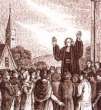






 You thought you knew Jack?
You thought you knew Jack?Better known as C.S. Lewis. Clive Staples Lewis was born in 1898 in Belfast, Ireland. At an early age of 3 or 4 he changed his name to Jack. Do we blame him. Interesting facts of Jack, includes that he liked to spend time with friends at the Eagle and Child pub, drinking pints, and smoking pipes.
He was an avid reader. Lewis distrusted the latest trends and in all
aspects of culture: People become enamored with what's hip and plunge " into it because it seems successful. " You may call Lewis" old school." Lewis lived a very modest life; he was a very generous man, giving away two-thirds of his income to Church and other charities. Jack did not travel much nor cared too. Jack never learned to drive a car. Jack loved the sea, but disliked swimming. He wasn't one for small talk, so he avoided social functions and he said " I have a distaste for all that is public." He hated radio and television though later his voice would be heard on the radio. In World war 1 he suffered a wound to his wrist which later would cause pain while writing the 37 books he would produce. Jack memorized books including Greek and Latin books and would recite them from memory. If he like a book he wanted to own it so he could read it again and again. He enjoyed reading so much that he would read and walk at the same time, even when getting ready and walking out the door. Truly a man after my own heart.
Jack of many trades
Many different genres of literature Jack wrote; from theology (Mere Christianity)( God In The Dock). My first apologetic books I read. Poetry (Dymer), allegorical novel (The pilgrim's Regress) this would not be politically correct today, it talks about dark skin girls, which represent lust. Philosophy ( The Abolition of Man), children "suposal" fairy tale ( The Chronicles of Narnia), space travel fiction (The ransom Trilogy) interesting in light of the fact that he had a distaste to travel. Myth (Till WE Have Faces), analogue (Letters to Malcolm), literary criticism ( Discared Image) and autobiography ( Surprised by Joy).
Surprise!!! Joy
Yes indeed he surprised many including himself in when in 1957 he started to fall in love with Joy his wife, that's right, he first entered into a civil marriage with Joy. In 1956 Joy's visa renewal was refused by the British authorities, unless she would marry an Englishmen she was to return to the United States. Later in 1956 they would a have legal ceremony. She was 37 years of age and he was 55 years of age when they tied the knott. Only four years into their relationship she would die of cancer. Joy's death nearly destroyed Jack. In response to his pain he wrote the book "A Grief Observed". A book that many have found helpful in the loss of a loved one.
What does Jack know?
Though Jack has contributed much to Christian subculture and has influenced Christians to engage in the arena of apologetics, he did not subscribe to penal substitution, and biblical inerrancy. He believed in baptismal regeneration and purgatory. Even with this marred deficient theology he has impacted much of Christendom, including myself. He paved the way for a passion for apologetics and to worship God in the duty of delight, with the whole mind and intellect. He helped fuel a passion for reading. In "God In The Dock" chapter 4, titled "On the Reading of Old Book" we read "I do not wish the ordinary reader to read no modern books. But if he must read only the new or only the old, I would advise him to read the old." That is good sound advice. I might add Puritan literature at that.
alledged allegory
Perhaps the single most common question about The Chronicles of Narnia asks whether Lewis wrote the series as an allegory. After all, even if your biblical knowledge is limited to a few Sunday school classes in third grade, you probably notice that Aslan has many similarities to Jesus Christ. If Lewis added that symbolism on purpose, does that mean that everything in Narnia represents something in the Bible? C.S. Lewis makes clear that he didn't write the Narnian Chronicles as a biblical allegory. But you may be asking: How can this be true given the obvious symbolism used throughout the series? In order to understand Lewis's side of the story, you need to understand the difference between allegory and something he called supposal.
An allegory is a literary device in which an author uses the form of a person, place, or animal to represent an abstract idea. For example, an eagle can represent the abstract concept of "freedom," a witch can represent "evil," or a photo of yours truly can express "amazing, profound wisdom." Some of the more popular literature in history is allegorical. In Dante Alighieri's The Divine Comedy, for example, Dante represents humanity as he journeys through Hell, Purgatory, and Paradise. In John Bunyan's The Pilgrim's Progress, concepts like hope and mercy become real-life characters in his saga of a man (named Christian) searching for salvation. So too, Lewis's first book written after his Christian conversion was The Pilgrim's Regress, a Bunyan-like allegory that describes his road to the Christian faith. In The Allegory of Love, Lewis writes that when you use allegory, "you can start with [facts] . . . And can then invent . . . Visible things to express them." He adds, "What is good or happy has always been high like the heavens and bright like the sun. Evil and misery were deep and dark from the first." A slightly broader definition of allegory applies when an author represents real people or places in a fictional context. George Orwell's Animal Farm is a well-known example of this allegorical type. As a way of addressing the issues surrounding the Russian Revolution, Marx, Lenin, Stalin, and other real historical figures are represented as pigs on a farm.The Chronicles of Narnia is not in this genre. Lewis did not write the series as an allegory using his fantasy setting to represent abstract concepts or real people. In terms of literary style, the series bears no parallels to allegorical works like The Divine Comedy, Animal Farm, or even Lewis's own The Pilgrim's Regress.In fact, Lewis explicitly warns readers against trying to make a one-for-one match between Narnia and the real world. In a May 1954 letter to a fifth grade class in Maryland, he writes, "You are mistaken when you think everything in the books 'represents' something in this world. Things do that in The Pilgrim's Progress but I'm not writing in that way."
Supposedly, this is a supposal
Although Lewis makes it clear that The Chronicles of Narnia isn't an allegory, he doesn't deny that some symbolism was written into the series. But, to understand his approach, you need to recognize that Lewis differentiates allegory from something he calls supposal. In a December 1959 letter to a young girl named Sophia Storr, he explains the difference: I don't say. 'Let us represent Christ as Aslan.' I say, 'Supposing there was a world like Narnia, and supposing, like ours, it needed redemption, let us imagine what sort of Incarnation and Passion and Resurrection Christ would have there.' Allegory and supposal aren't identical devices, according to Lewis, because they deal with what's real and what's unreal quite differently. In an allegory, the ideas, concepts, and even people being expressed are true, but the characters are make-believe. They always behave in a way reflective of the underlying concepts they're representing. A supposal is much different; the fictional character becomes "real" within the imaginary world, taking on a life of its own and adapting to the make-believe world as necessary. If, for example, you accept the supposal of Aslan as true, then Lewis says, "He would really have been a physical object in that world as He was in Palestine, and His death on the Stone Table would have been a physical event no less than his death on Calvary." Aslan isn't an allegory of Jesus Christ. Instead, he's a supposal. Lewis emphasizes this point in a December 1958 letter to a lady named Mrs. Hook: [Aslan] is an invention giving an imaginary answer to the question 'What might Christ become like if there really were a world like Narnia and He chose to be incarnate and die and rise again in that world as He actually has done in ours?' This is not allegory at all. Much of The Chronicles of Narnia is built on the concept of supposal. For example: Suppose Christ came into the world of Narnia as Aslan. What would he be like? Suppose Aslan created Narnia out of nothing and centuries later brought it to a conclusion. How would these stories play out? Suppose evil were introduced into Narnia. What would that be like? Suppose a person or talking animal could freely choose to obey or disobey Aslan. What would life in Narnia be like? By using supposal, Lewis doesn't feel compelled to have a direct 1 to-1 correlation between the experiences of Aslan and the real life of Jesus Christ. In his letter to Sophia Storr, Lewis talks of this freedom: "When I started The Lion, the Witch and the Wardrobe, I don't think I foresaw what Aslan was going to do and suffer. I think He just insisted on behaving in His own way." Using supposal as the vehicle for getting him there, Lewis views The Chronicles of Narnia as myth. He explains that an allegory is a story with a single meaning, but a myth is a story that can have many meanings for different readers in different generations. According to Lewis, an author puts into an allegory "only what he already knows," but in a myth, he puts "what he does not yet know and could not come by in any other way."
So you think you know Jack?

















